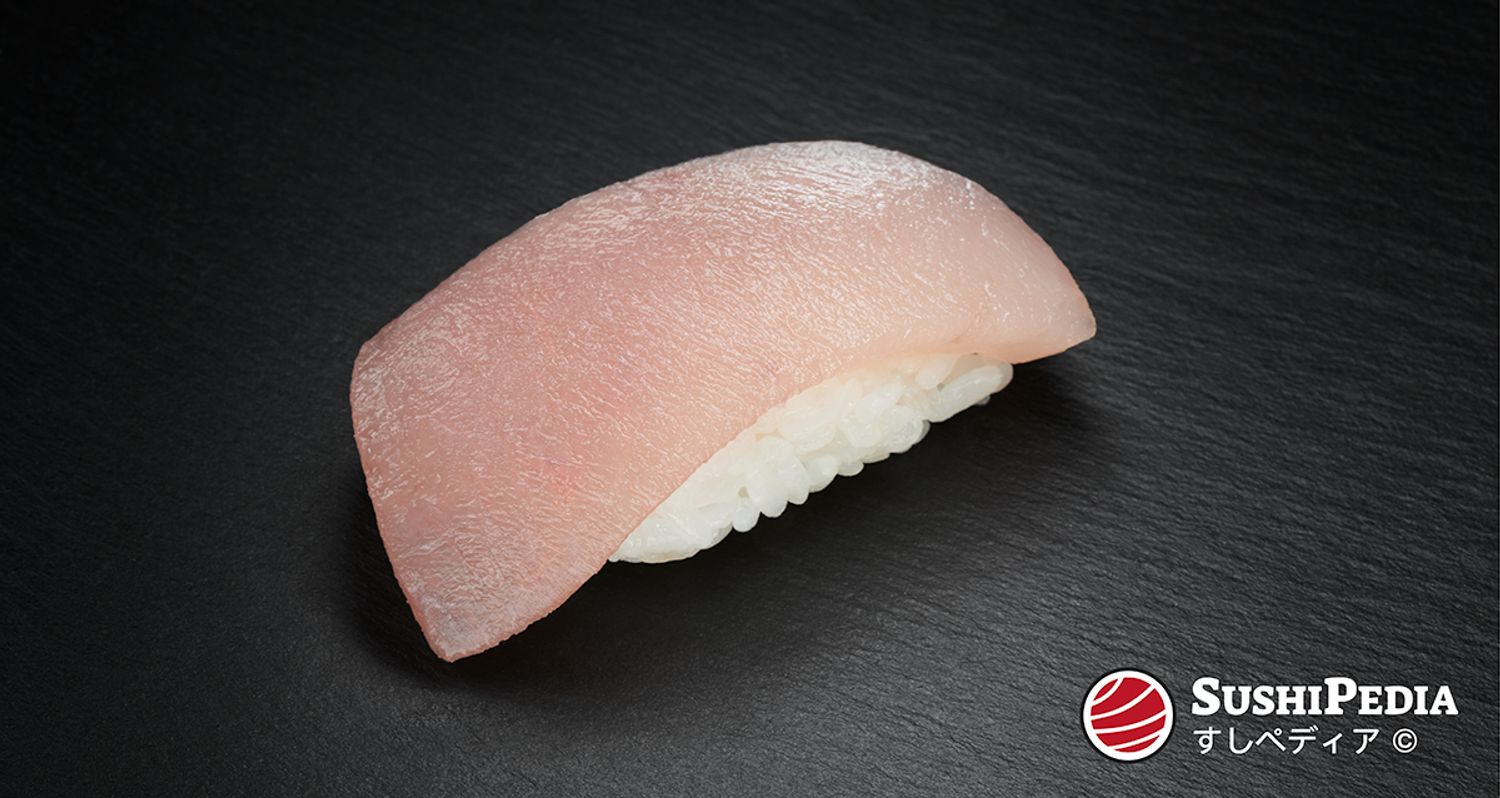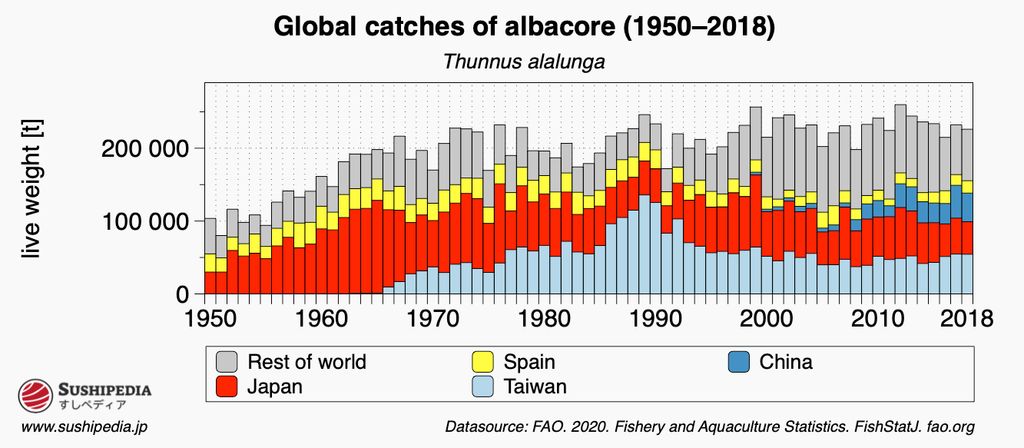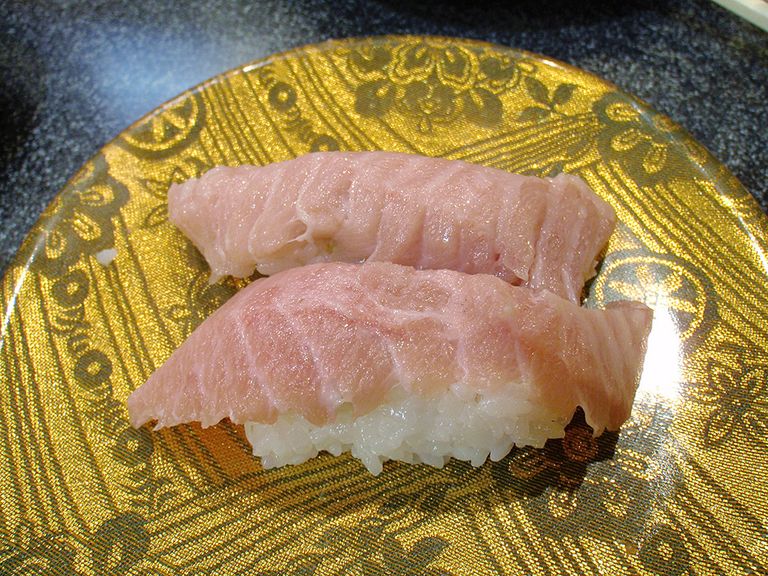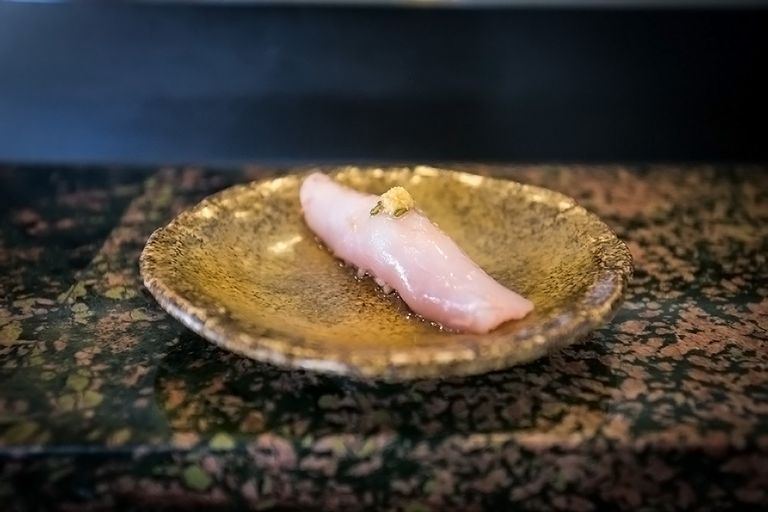Binnaga Sushi
A Comprehensive Overview of Albacore in Japanese Sushi Cuisine
ビンナガ(ビンチョウ)すし 、 鬢長寿司 
What is Binnaga or Binchou?
The Japanese name for albacore (Thunnus alalunga) in Japanese is binnaga 鬢長 or binchō ビンチョウ. This species is distinguished by its long, whip-like pectoral fins, which give it the alternative name “longfin tuna” and differentiate it from other tuna species. The most commonly used meat for sushi preparation is the belly meat, known as bintoro びんとろ. It is characterized by its soft texture and rich flavor, making it a preferred ingredient for sushi and sashimi. Binnaga is valued as a precious food fish, has significant economic importance, and is increasingly used as an ingredient for sushi or sashimi outside of Japan as well.
Binnaga for Sushi or Sashimi
For sushi and sashimi, mainly individuals caught in cold regions are suitable. In contrast to specimens from warmer regions, these have a significantly higher fat content. The fat meat of these fish is called bintoro, occasionally the term is also used for whole specimens from cold regions. Albacore tuna from warm waters, on the other hand, lack the necessary fat content to produce a full-bodied umami flavor. The fatty meat is tasty and preferred for the preparation of sushi and sashimi. The lean red meat (akami, あかみ), on the other hand, is less appealing and is rarely used as an ingredient for sushi or sashimi.
The remarkably bright, fatty meat is slightly sweetish, barely sour, very tender and melts well on the tongue. A common method of preparation is the tataki method, in which the meat is heated briefly and then quenched with ice water. This keeps the meat inside still raw, the texture gains firmness and its taste becomes more aromatic. The meat of the albacore tuna should be light in color, from white-pink to deep pink and should not show any bloodstains or bruises.
Sushi from lean binnaga meat exhibits a mild flavor profile. This subtle taste is easily overpowered by other flavors, so it is advisable to use soy sauce sparingly when consuming it. The lean meat contains little to no umami, the savory taste that is more prominent in fattier meats. Additionally, the taste of iron is almost non-existent, which can be advantageous for those who do not enjoy this intense flavor. The texture of the lean meat is very soft, possibly watery, and tender. These characteristics make it particularly pleasant and easy to chew, enhancing the culinary experience by making it more gentle. The low-fat content contributes to a lighter and less filling sensation, which is especially appreciated during the hot season.
Compared to other tunas, albacore tuna is much cheaper, milder in taste, paler in color and less firm. It is usually found fresh, smoked or processed as high quality canned fish. It is one of the most economically significant edible fish of our time and is considered a popular main ingredient or side dish in many dishes worldwide. Albacore tuna is regularly used as a filling for Japanese rice balls (onigiri) which are offered in Japanese convenience stores (konbini). Nigiri binnaga sushi or sashimi is a popular ingredient in cheap sushi restaurants, supermarkets, and conveyor belt sushi restaurants (kaitenzushi).
Best Season
Binnaga sushi or sashimi is a popular winter dish. Due to the global spread and good logistical availability, the fish is also available all year round.
Binnaga in Japan
In addition to the names binnaga and binchō, albacore tuna are also occasionally referred to as tonbo トンボ, a term that stands for “dragonfly” in Japanese. There are also special names for individuals that were caught in cold waters and therefore have a higher fat content, such as bintoro ビントロ or abura tonbo 脂トンボ. Leaner individuals, on the other hand, are also known as gari binchō ガリビンチョウ or gari ton ガリトン.[1]
Etymology
The Japanese trivial name “binnaga” for Thunnus alalunga is derived from the distinctive physical characteristics of this species, in particular its exceptionally long pectoral fins. These can be longer than the second dorsal fin and in some specimens even reach the rear, smaller fins on the back. The name binnaga comes from the visual association of these fins with the temporal hairs or sideburns, which are called bin 鬢 in Japanese, while naga 長 symbolizes “long” or “length”. The regional name tonbo, which means “dragonfly”, is also derived from the similar appearance of the pectoral fins, which are reminiscent of the delicate wings of a dragonfly.
Characteristics and Ecology of Binnaga
Adult binnaga reach a total length of 140 cm and weigh 60 kg. However, most landed fish have a size of 50 to 100 cm. Binnaga is a worldwide common deep-sea fish, which is mainly found in the upper and middle layers of water and penetrates to depths of at least 380 meters in the Pacific and up to 600 meters in the Atlantic. They cover very large distances and form groups with other conspecifics of the same age. Its preferred water-temperature is between approximately 16 and 20 °C. As a predatory fish, it feeds on a wide range of smaller schooling fish, crustaceans, and squid.
Economy of Binnaga

SushiPedia. Global catch of albacore (1950-2018). All rights reserved ©
The economy of albacore tuna (Thunnus alalunga) plays an important role in the global fishing industry. Albacore tuna is prized for its firm, mild flesh and high omega-3 fatty acid content and is mainly used for canned and fresh products. The demand for Albacore tuna drives the market price and impacts the livelihoods of coastal communities and industrial fisheries. Sustainability certifications and catch quotas are crucial to protect stocks and ensure long-term economic viability.
The global albacore tuna economy is relatively stable, but faces some challenges. Albacore tuna stocks have come under pressure in some regions due to overfishing, which has led to catch quotas and restrictions to ensure sustainability. Demand for albacore tuna remains strong, particularly in markets such as the US, Japan, China and Europe, where it is used for canning and sashimi.[2] Albacore tuna prices have fluctuated in recent years due to various factors such as catch volumes, market demand and fishing vessel fuel costs. Regional fisheries organizations such as the Inter-American Tropical Tuna Commission (IATTC) and the Western and Central Pacific Fisheries Commission (WCPFC) set catch limits and manage the albacore tuna fishery to promote sustainability.[3][4]
Overall, the Albacore tuna industry faces sustainability challenges, but demand remains stable and efforts are being made to manage the fishery responsibly.
Season Calendar for Binnaga
The calendar shown does not provide information on fishing times, but marks the periods in which binnaga is considered particularly tasty.
Warnings related to Binnaga
Video about Binnaga Sushi
External video embedded from: youTube.com. Credit k harata. 南紀・那智勝浦浦島での鬢長マグロ解体.
Species of Binnaga
The following species are regarded as authentic binnaga. Either historically, according to the area of distribution or according to the common practice in today's gastronomy:
Sources and Further Reading
- [1]<公式>焼津船元 まぐろ家福坊本店, 福一漁業株式会社. 『ビンチョウマグロとは 特徴、旬、生息地(海域、漁場)など (About Bincho Tuna Characteristics, season, habitat (sea area, fishing grounds), etc.)』. 2020. Source retrieved 4/12/2022
- [2]Bởi Meksea Team. Tuna exports to China increase sharply. 2023-09-13. Source retrieved 6/15/2024
- [3]Northern albacore tuna catches. Inter-American Tropical Tuna Commission (IATTC). Source retrieved 6/15/2024
- [4]Harvest Strategy for North Pacific Albacore Fishery. Western and Central Pacific Fisheries Commission (WCPFC)
- [5]Fish and Fishery Products Hazards and Controls Guidance, June 2022 Edition. U.S. Department of Health and Human Services, Food and Drug Administration Center for Food Safety and Applied Nutrition. 2022
- Becky Selengut. Good Fish: 100 Sustainable Seafood Recipes from the Pacific Coast. Sasquatch Books, Seattle. 2018
- Bruce B. Collette, Cornelia E. Nauen. Species Catalogue, Vol. 2, Scombrids of the World. An Annotated and Illustrated Catalogue of Tunas, Mackerels, Bonitos and Related Species Known to Date, FAO Fisheries Synopsis, Vol. 2 (125). Food and Agriculture Organization of the United Nations (FAO), Rome. 1983
- Casson Trenor. Sustainable Sushi: A Guide to Saving the Oceans One Bite at a Time. North Atlantic Books, Berkeley. 2009
- Fisheries and Aquaculture Department. Fishery and Aquaculture Statistics. Global production by production source 1950-2018 (FishstatJ). Food and Agriculture Organization of the United Nations (FAO), Rome. 2020. Source retrieved 12/24/2020
- Jessica H. Farley, Ashley J. Williams, Simon D. Hoyle, Campbell R. Davies, Simon J. Nicol. Reproductive Dynamics and Potential Annual Fecundity of South Pacific Albacore Tuna (Thunnus alalunga). PLOS One 8 (4). 2013
- Ministry of Agriculture, Forestry and Fisheries (農林水産省). Sea-area Fishery Production Survey (海面漁業生産統計調査), 2018 Fisheries/Aquaculture Production Statistics (平成30年漁業・養殖業生産統計), Marine Fisheries Department (海面漁業の部), Department sea surface aquaculture (海面養殖業の部), Inland fishery aquaculture department (内水面漁業・養殖業の部). e-Stat, Government Statistical Office (政府統計の総合窓口). 2019. Source retrieved 12/24/2020
- Rainer Froese, Pauly Daniel. FishBase. The Leibniz Institute of Marine Sciences at the University of Kiel, FishBase.org, 2019. Source retrieved 12/24/2020
- Zahirah Dhurmeea, Iker Zudaire, Emmanuel Chassot, Maria Cedras, Natacha Nikolic, Jérôme Bourjea, Wendy West, Chandani Appadoo, Nathalie Bodin. Reproductive Biology of Albacore Tuna (Thunnus alalunga) in the Western Indian Ocean. PLOS One 11 (12). 2016
- IUCN Red List of Threatened Species. Version 2023-1
Image Credits
- TheDeliciousLife. Albacore Belly with Fried Tokyo Onions - Kiyokawa. flickr.com. Some rights reserved: CC BY 2.0. Changes applied: brightness, contrast, noise, white balance
- City Foodsters (Grace Chen, Jason Wang). Albacore. flickr.com. Some rights reserved: CC BY 2.0. Changes applied: brightness, contrast, noise, white balance
- SushiPedia. Bintoro Binnaga Sushi. All rights reserved ©
- takaokun. Bincho Toro Nigiri. flickr.com. Some rights reserved: CC BY 2.0. Changes applied: brightness, contrast, noise, white balance
- SushiPedia. Global catch of albacore (1950-2018). All rights reserved ©


